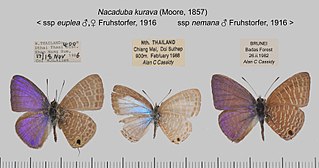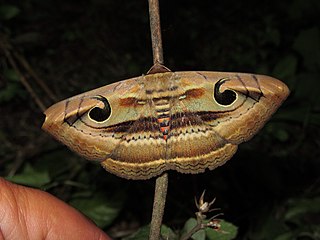| Sufetula cyanolepis | |
|---|---|
| Scientific classification | |
| Kingdom: | Animalia |
| Phylum: | Arthropoda |
| Class: | Insecta |
| Order: | Lepidoptera |
| Family: | Crambidae |
| Genus: | Sufetula |
| Species: | S. cyanolepis |
| Binomial name | |
| Sufetula cyanolepis Hampson, 1912 | |
Sufetula cyanolepis is a moth in the family Crambidae. It was described by George Hampson in 1912. It is found in Indonesia (Sulawesi). [1]

Moths comprise a group of insects related to butterflies, belonging to the order Lepidoptera. Most lepidopterans are moths, and there are thought to be approximately 160,000 species of moth, many of which have yet to be described. Most species of moth are nocturnal, but there are also crepuscular and diurnal species.

The Crambidae are the grass moth family of lepidopterans. They are quite variable in appearance, the nominal subfamily Crambinae taking up closely folded postures on grass stems where they are inconspicuous, while other subfamilies include brightly coloured and patterned insects which rest in wing-spread attitudes.
Sir George Francis Hampson, 10th Baronet was a British entomologist.
The wingspan is about 14 mm. The forewings are ochreous largely suffused with red-brown and fuscous, and with scattered patches of silvery-blue scales. The base and the costal area to the antemedial line are blackish and the antemedial line is ochreous, defined on each side by blackish and with silvery-blue scales on its outer edges. There are two minute semicircular marks defined by black on the medial part of the costa and there is a diffused blackish discoidal annulus. The postmedial line is ochreous defined on each side by blackish and with silvery-blue scales on its inner edge. There are some minute silvery-blue streaks before the termen and there is a dark terminal line. The hindwings are ochreous with a diffused oblique medial black-brown band from the cell to the inner margin, as well as an ochreous postmedial line, which is obsolete on the costal area and then defined on the inner side by a black line and with a broad diffused blackish band on the outer area. There is a subterminal series of diffused black striae with slight patches of silvery-blue scales before termen on the costal half. [2]

The wingspan of a bird or an airplane is the distance from one wingtip to the other wingtip. For example, the Boeing 777-200 has a wingspan of 60.93 metres, and a wandering albatross caught in 1965 had a wingspan of 3.63 metres, the official record for a living bird. The term wingspan, more technically extent, is also used for other winged animals such as pterosaurs, bats, insects, etc., and other fixed-wing aircraft such as ornithopters. In humans, the term wingspan also refers to the arm span, which is distance between the length from one end of an individual's arms to the other when raised parallel to the ground at shoulder height at a 90º angle. Former professional basketball player Manute Bol stands at 7 ft 7 in (2.31 m) and owns one of the largest wingspans at 8 ft 6 in (2.59 m).






